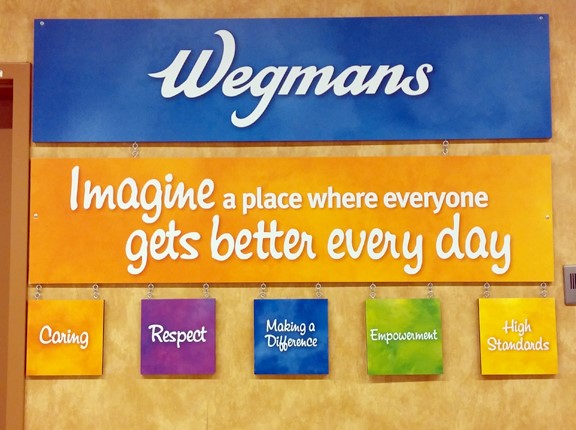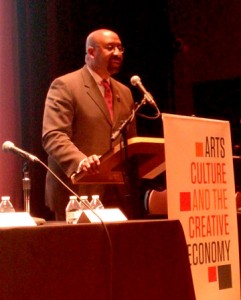
by Rachel Dukeman | Oct 25, 2016 | Entrepreneur, Marketing, Policy, Thought Leaders
Who doesn’t love Wegman’s?
The fresh produce. The large beautifully designed aisles. Carefully chosen offerings that are sustainable, healthy and delicious. Each decision that goes into making Wegman’s such an inviting space to load up on crunchy apples and aged cheddar is guided by the institution’s core values. Which means everyone from the CEO to the person stocking the prepared foods knows exactly the environment that Wegman’s strives to create – and more importantly doesn’t waste time with choices that run counter to those values.
What are core values, exactly?
Well, first a definition: Core values are attributes shared by key stakeholders in the organization. They embody the brand identity, are used in the tone of the value proposition, and describe standards held by the organization. Most simply, core values are adjectives or common phrases that describe the personality traits of the people involved with the organization – from staff to investors to the clientele. You with me?
How can core values increase productivity and efficiency?
Core values increase productivity by aligning personalities and standards in a work place. This increases efficiency by focusing attention on work that will be most productive or eliminating the work that is not.
It’s simple and you’re probably already doing it. Let’s say you’re hiring. In the interview process, you’re most likely going to look for someone who complements your existing team. If you acknowledge what traits your staff share that make them work together so effectively and look for those traits in a new hire, you know you’ll build a stronger team.
You’re already doing this, right? Keep going.
So take it a step or two further by keeping those traits identifiable to all stakeholders. Likewise, not taking on a client or vendor who doesn’t share your core values helps you avoid situations that won’t be a good fit.
For example, one of the core values at R&R Creative is creativity. If someone approaches us with a project where there’s absolutely no room to propose new or innovative solutions then chances are we won’t be happy doing the project. Unhappy teammates make for an unhappy work environment which could result in our product suffering. The beauty here is that clearly stating our core values increases efficiency because they enable us to say no, and focus on what will end up being more productive in the long run.
What’s next?
Now, if you don’t know your core values or those of your organization I suggest you find out. If their answer is: what core values? Then maybe it’s time to make the case. Lucky you, R&R Creative knows just where to start. We can show you how to feature those values throughout your organization and marketing strategy to make sure you are attracting the right vendors, customers and team members, which means winning half the battle right from the start.
by Rachel Dukeman | Dec 1, 2014 | Entrepreneur, Marketing, Nonprofit Management, Policy
I, Rachel Dukeman, founded R&R Creative in 2007 during an economic downturn in an effort to broaden arts and cultural audiences through effective market research, audience engagement, and marketing services on a contract-by-contract basis. The pressure to maintain programmatic quality during the Recession forced nonprofits to hone their entrepreneurial skills and ability to manage projects according to priority, viability and strategic direction in a high velocity climate. More succinctly, they were forced to do more with less, being held accountable for the “success” of each program. In response, R&R Creative further developed tools to make planning easy to implement and metrics to track progress towards set goals.
The Greater Philadelphia Cultural Alliance’s 2014 Portfolio noted a distinct set of organizations that not only recovered from the recession faster than the sector as a whole… they grew. These “Growth” organizations: spend more on marketing and fundraising, rely more on paid attendance and hire independent contractors. Proving to R&R Creative that our approach to helping the cultural nonprofit sector was a step in the right direction.
It is the current goal of R&R Creative to impact on the arts and culture sector in the best way possible: by improving policy and management strategy.
- Dukeman, Rachel. “Three Recession Results That Can Benefit NonProfits.” Philadelphia Social Innovations Journal. May 2012. Link.
- Greater Philadelphia Cultural Alliance. “2014 Portfolio.” 2014. Link.

by Rachel Dukeman | Nov 13, 2014 | Policy
Last night I went to the Creative Philadelphia Town Hall, held at the Clef Club on South Broad Street. At the event we heard remarks from:
- Frank Sherlock, City ofPhiladelphia’s Poet Laureate
- Joseph Kluger, Advisory Council
- The Honorable Mayor Michael Nutter
- Helen Haynes, Chief Cultural Officer
- Veronica Castillo-Perez, Pennsylvania Council of the Arts – Consultant
- Gayle Isa, Asian Arts Initiative, Founder and Executive Director
- Valerie Gay, Art Sanctuary, Executive Director
- Laurel Raczka, Painted Bride Art Center, Executive Director
- Lisa Nelson-Haynes, Painted Bride Art Center, Associate Director
- Councilwoman Blondell Reynolds-Brown
- Margot Berg, Public Art Director
- Tu Huynh, City Hall Exhibitions Manager
- Jacque Liu, Percent for Art Project Manager
- Lindsay Tucker So, Research & Policy Associate
- Pamela Yau, Special Projects Coordinator
- June O’Neill, Philadelphia Cultural Fund
- Mark J. Stern, Kenneth L. M. Pray Chair Professor of Social Policy and History, Co-director, Urban Studies Program, Principal Investigator, Social Impact of the Arts Project – University of Pennsylvania
There’s a chance I’m missing someone… because I’m pretty sure we heard from a half of Philadelphia.
Before you write my sarcasm off as cynicism, know that my ribbing is rooted in passion -– for the arts. Everyone on that list is an excellent speaker, proud arts supporter, and influential leader. I’m just not sure why they were preaching to the choir.
When invited to a “Town Hall” meeting, I was expecting to learn about the current arts and culture opportunities or trends in Philadelphia and what we, as invited professionals in the field, could do to further engage and support it. The best part of the meeting was the panel from the City’s Office of Arts, Culture and Creative Economy – however they weren’t even listed on the marketing collateral.
The second best part of the event was the keynote on the Social Impact of the Arts Project. I wish we didn’t just hear the fable, but discussed the moral of the story as well. Again, how was telling an arts and culture professional audience that arts has an impact on society not superfluous? Where was our call to action?
My expectations of a Town Hall informal presentation on current events and a discussion surrounding them predisposed me to be disappointed with the conference-style panel discussions and “short, but sweet” keynote. The event was too long and contained too many messages. With the utmost respect for our colleagues on the first panel, I’m not sure why they were on the docket. We went from hearing about leadership succession to placemaking to collaborative partnerships to diversity in under an hour.
That said, there were some good takeaways from the event; things like the Percent for Art program, hearing continued support commitments from City Leaders such as the Mayor and Councilwoman Blondell Reynolds-Brown, and learning about the In Store forgivable loan program. Once I get over my frustrations with the event, I’ll write a part two discussing the positive parts.



